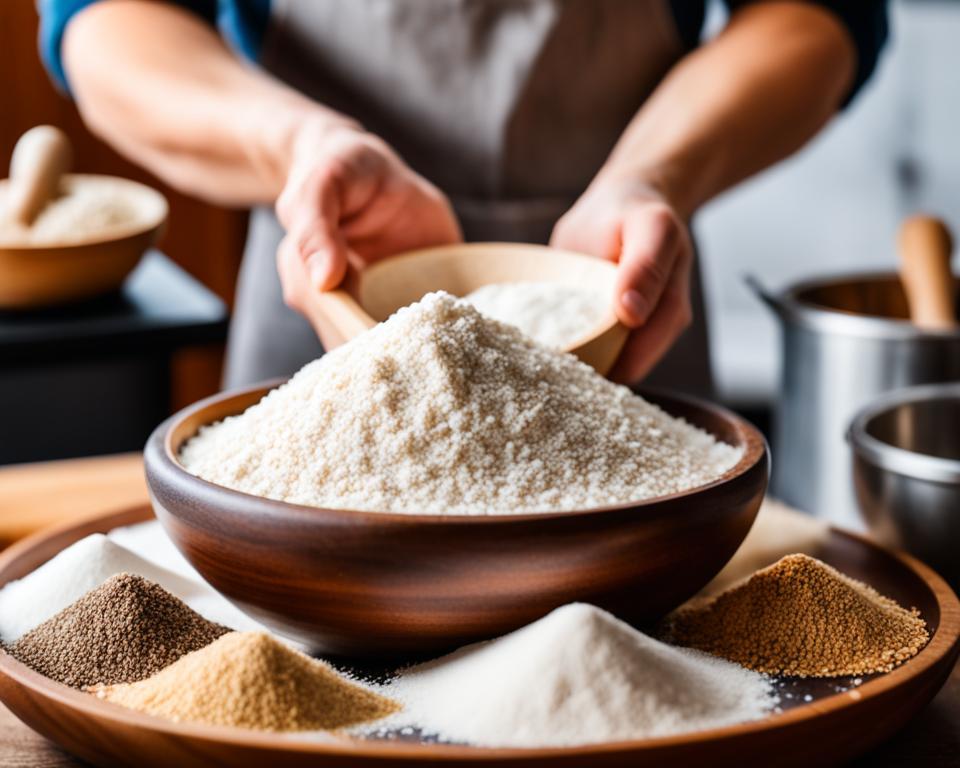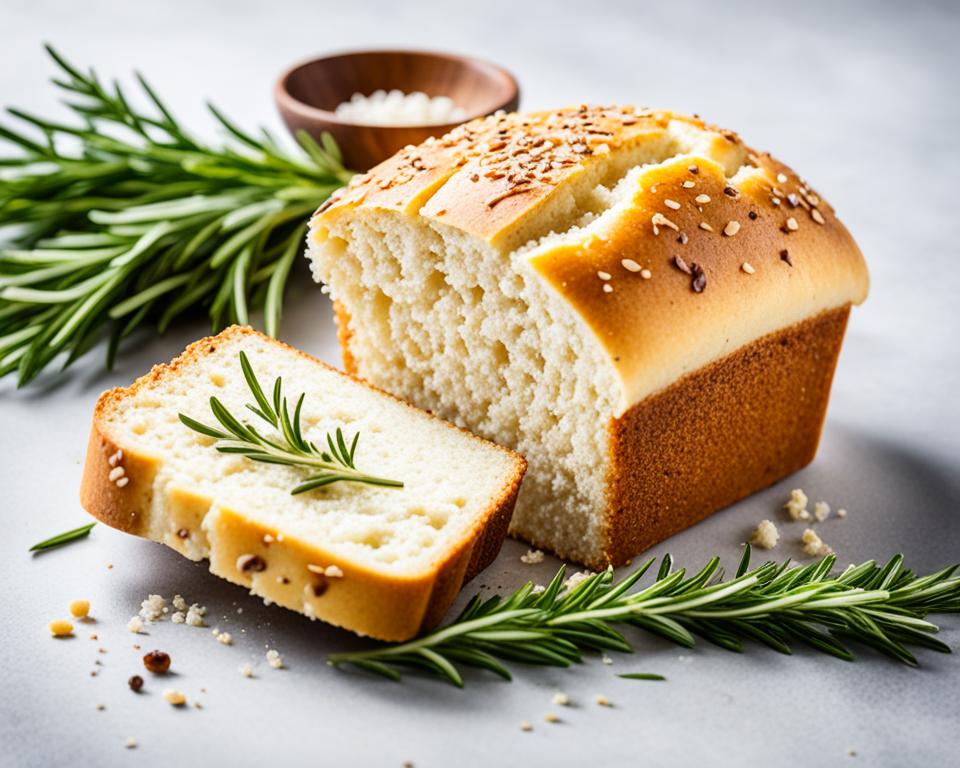Rice flour bread is a great option for those who follow a gluten-free diet or have gluten sensitivities or intolerances. It can be difficult to find tasty and satisfying gluten-free bread alternatives. Rice flour bread is easy to make and offers a texture and flavor similar to cornbread. With simple ingredients and a quick preparation time, you can enjoy delicious homemade bread that is gluten-free.
Key Takeaways:
- Rice flour bread is a gluten-free alternative that is easy to make at home.
- It has a texture and flavor similar to cornbread.
- Rice flour bread can be customized with various ingredients and flavors.
- Proper pan size and avoiding overmixing are important tips for successful rice flour bread making.
- Rice flour bread can be stored in the freezer for longer shelf life.
What is Rice Flour Bread?
Rice flour bread is a type of gluten-free bread that is perfect for individuals with gluten sensitivities or those following a gluten-free diet. Unlike traditional wheat-based breads, rice flour bread does not contain gluten, making it a suitable alternative. This bread is leavened using baking powder instead of yeast. It is made primarily from ground rice grains, resulting in a unique texture and flavor.
Rice flour bread is also a vegan-friendly option, although it does require the use of eggs to hold the bread together. It offers a versatile base for different flavors and variations and can be enjoyed by individuals with various dietary preferences.
“Rice flour bread is a gluten-free bread alternative that uses baking powder instead of yeast.”
Benefits of Rice Flour Bread
Rice flour bread offers several benefits for individuals who follow a gluten-free diet or have gluten sensitivities. It is a great alternative to traditional wheat-based breads and provides a gluten-free option for those who may struggle to find suitable bread alternatives.
One of the key advantages of rice flour bread is its ease of preparation. Unlike yeast-based breads that require lengthy rising times, rice flour bread can be made quickly, saving time in the kitchen. Its simple preparation process makes it accessible to even novice bakers, allowing anyone to enjoy freshly baked gluten-free bread at home.
Rice flour bread also has a texture and flavor that is similar to cornbread. The moist and slightly crumbly texture, along with a hint of sweetness, makes rice flour bread a delicious choice for those who love the taste and mouthfeel of cornbread but prefer a gluten-free option. Whether enjoyed on its own or as part of a meal, rice flour bread adds a touch of comfort and satisfaction to any dining experience.
“Rice flour bread offers a gluten-free alternative that is easy to make and provides a similar taste and texture to cornbread.”
Overall, rice flour bread is a versatile and tasty option for individuals seeking a gluten-free bread alternative. Its benefits include:
- Gluten-free option: Rice flour bread caters to individuals who follow a gluten-free diet or have gluten sensitivities.
- Easy to make: The quick preparation time and simple ingredients make rice flour bread accessible to all, regardless of baking expertise.
- Quick preparation time: Compared to yeast-based breads, rice flour bread requires less time for preparation, allowing for a quicker baking process.
- Similar to cornbread: With its texture and flavor reminiscent of cornbread, rice flour bread offers a satisfying alternative for those who enjoy cornbread but need a gluten-free option.
Next, we will dive into a detailed rice flour bread recipe, guiding you through each step of the process to ensure a successful outcome.
Rice Flour Bread Recipe
To make delicious rice flour bread, you will need the following ingredients:
- 2 cups rice flour
- 1 tablespoon baking powder
- 2 tablespoons sugar
- 1/2 teaspoon salt
- 2 eggs
- 1/4 cup melted butter
You will also need the following equipment:
- A mixing bowl for combining the ingredients
- A bread pan for baking the bread
- Oven mitts for safely handling the hot pan
- A wire cooling rack for cooling the bread after baking
Now, let’s get baking:
- In a mixing bowl, combine the rice flour, baking powder, sugar, and salt.
- In a separate bowl, beat the eggs and melted butter together.
- Add the wet ingredients to the dry ingredients and mix until well combined.
- Transfer the batter to a greased bread pan.
- Bake in a preheated oven at 350°F for 35-40 minutes or until a toothpick inserted into the center comes out clean.
- Remove from the oven and let the bread cool in the pan for a few minutes.
- Using oven mitts, carefully remove the bread from the pan and transfer it to a wire cooling rack to cool completely.
Once the bread has cooled, it’s ready to be sliced and enjoyed! Serve it plain, toasted, or with your favorite spreads and toppings. Enjoy the delicious taste and texture of homemade rice flour bread.
Tips for Making Rice Flour Bread
To ensure successful rice flour bread, there are a few tips to keep in mind.
- Use the Proper Pan Size: Choosing the right pan size is crucial for allowing the bread to rise properly in the oven. A pan that is too small can result in a dense and undercooked loaf.
- Avoid Overmixing: Overmixing the batter can lead to a sunken top in the bread. It’s important to mix the ingredients just until they are combined. This will help achieve a light and fluffy texture.
- Grease the Pan: Lightly greasing the bottom of the pan while leaving the sides ungreased can help the bread cling to the sides and provide support as it expands during baking. This can prevent the bread from collapsing in the center.
By following these tips, you can ensure that your rice flour bread turns out perfectly every time.

These tips will help you bake delicious rice flour bread with a fluffy texture and maximum rise.
Nutritional Information of Rice Flour Bread
Rice flour bread is not only a delicious gluten-free alternative but also offers nutritional benefits. Here is a general breakdown of the nutritional information for rice flour bread:
| Nutrient | Amount Per Serving |
|---|---|
| Calories | Approximately 100-120 calories* |
| Carbohydrates | Approximately 18-22 grams |
| Protein | Approximately 2-4 grams |
| Fat | Approximately 1-3 grams |
*The calorie count may vary depending on the specific recipe and serving size.
As you can see, rice flour bread is generally lower in calories compared to traditional wheat-based breads, making it a suitable option for those watching their calorie intake. It contains a moderate amount of carbohydrates, providing energy for your body. Additionally, rice flour bread typically has a lower fat content. However, the nutritional information may vary depending on the addition of fats or sweeteners in the recipe and the specific slice size.
It’s important to note that these values are approximate and based on general guidelines. For more accurate nutritional information, it’s recommended to refer to the specific recipe or consult a registered dietitian or nutritionist.
With its delightful taste and nutritious profile, rice flour bread is a great choice for individuals seeking a gluten-free alternative without compromising on flavor or health benefits.
Variations and Additions to Rice Flour Bread
Rice flour bread can be customized with various additions and flavors to suit your taste preferences. Whether you’re looking for a savory twist or a sweet indulgence, there are many options to explore.
Savory Additions
For a savory variation, you can add ingredients such as:
- Mixed seeds: Add a combination of sesame seeds, sunflower seeds, or pumpkin seeds for added crunch and nutritional benefits.
- Sundried tomatoes: These flavorful tomatoes add a tangy and slightly sweet taste to the bread, enhancing its overall profile.
- Olives: Incorporate chopped olives to infuse the bread with a rich and briny flavor.
These additions not only provide extra texture and taste but also create unique flavor profiles that can elevate your rice flour bread.
Sweet Options
If you have a sweet tooth, you can transform your rice flour bread into a delightful treat by making a few adjustments:
- Reduce the salt: Sweet versions of rice flour bread can benefit from a reduction in salt, allowing the sweetness to shine through.
- Add more sugar: Increase the amount of sugar to enhance the overall sweetness of the bread.
- Include cinnamon or dried fruit: Sprinkle cinnamon on the dough or incorporate dried fruit like raisins or cranberries to create bursts of flavor.
These sweet additions will give your rice flour bread a touch of sweetness that pairs perfectly with your favorite spreads or jams.
Herbs and Seasonings
If you enjoy the aromatic qualities of herbs, consider seasoning your rice flour bread with:
- Basil: Add a fresh and fragrant taste to the bread with basil leaves.
- Rosemary: Incorporate rosemary for a savory and earthy flavor.
- Dill: Infuse the bread with the distinctive taste of dill for a unique twist.
- Thyme: Enhance the overall aroma and flavor with thyme leaves.
- Italian seasoning: Create an Italian-inspired bread by using a blend of dried herbs like oregano, basil, rosemary, and thyme.
These herbs and seasonings can provide a burst of freshness and complexity to your rice flour bread, making each bite a delightful experience.
With these variations and additions, you can unleash your creativity and experiment with different flavors to personalize your rice flour bread. Whether you prefer savory combinations or sweet indulgences, there’s a world of possibilities to explore!
Homemade Rice Flour
If you can’t find rice flour in stores, don’t worry! You can easily make your own homemade rice flour. There are two methods you can use to create this gluten-free flour in the comfort of your own kitchen.
High-Speed Blender Method
If you have a high-speed blender like a Vitamix or Blendtec, this method will quickly turn uncooked rice into a fine flour. Here’s how:
- Take uncooked rice and add it to the blender.
- Blend on high speed until the rice turns into a fine powder, resembling store-bought rice flour.
- Make sure to blend in short bursts and scrape down the sides of the blender to achieve an even texture.
Regular Blender or Food Processor Method
If you don’t have a high-speed blender, fret not! You can still make rice flour using a regular blender or food processor. Follow these steps:
- Soak the rice in water overnight to soften it.
- Drain the soaked rice and spread it out on a clean kitchen towel or paper towels.
- Let the rice dry completely. Ensure there is no moisture left to prevent clumping during the blending process.
- Add the dried rice to your blender or food processor.
- Pulse the machine in short bursts until the rice transforms into a smooth powder.
Remember, it’s important to ensure the rice grains are completely dry before grinding to avoid any clumps and achieve the desired consistency for your homemade rice flour.
By making your own rice flour at home, you have better control over the texture and quality of the flour. Plus, it’s a cost-effective solution and gives you the freedom to experiment with different types of rice to create unique flavors and textures in your recipes.

Now that you have learned how to make homemade rice flour, you can enjoy the satisfaction of using this versatile ingredient in your gluten-free baking adventures.
Freezing and Storage of Rice Flour Bread
After baking a delicious batch of rice flour bread, you may find yourself wondering how best to store it to keep it fresh. Thankfully, rice flour bread can be stored at room temperature for 3-4 days in a bread bowl or an airtight container. However, if you want to extend the shelf life of your bread and keep it fresh for longer, freezing is the way to go.
To freeze rice flour bread, start by slicing the loaf into individual slices. This will allow you to easily thaw only the amount you need at a time without exposing the entire loaf to air and potential freezer burn. Arrange the slices on a tray, making sure they are not touching each other, and place the tray in the freezer. Once the slices are frozen solid, transfer them to a freezer bag or an airtight container to protect them from freezer burn.
When properly stored in the freezer, rice flour bread can last for up to 3 months. To thaw and reheat the bread, simply take out the desired number of slices and let them come to room temperature. You can then pop them in a toaster or microwave until warmed through, ensuring you enjoy that freshly baked taste with every bite.
It’s important to note that if your rice flour bread becomes dry over time, there’s no need to worry. You can repurpose the bread in several creative ways. One option is to transform it into bread crumbs by pulsing the dried bread in a food processor. These breadcrumbs can be used for coating meats, veggies, or topping casseroles, adding a delicious crunch to your dishes. Additionally, rice flour bread makes a perfect candidate for French toast, as its slightly denser texture absorbs the custard beautifully. You can also turn your leftover rice flour bread into croutons by cubing the bread and toasting it in the oven with your favorite seasonings.
| Storage Option | Duration |
|---|---|
| Room Temperature (bread bowl or airtight container) | 3-4 days |
| Freezer (sliced, individually frozen, and stored in a freezer bag or airtight container) | Up to 3 months |
Tips for Freezing and Storage of Rice Flour Bread
- Slice the bread before freezing to easily thaw the desired amount.
- Arranging the slices on a tray prevents them from sticking together.
- Transfer the frozen slices to a freezer bag or an airtight container to protect them from freezer burn.
- Label the bag or container with the date to keep track of the bread’s freshness.
- Thaw the bread slices at room temperature and reheat as needed.
By following these simple tips, you can enjoy the goodness of rice flour bread even after it has been stored or frozen. So don’t worry about making a big batch – freeze the leftovers and have fresh bread at your fingertips whenever you need it!
Serving Ideas for Rice Flour Bread
When it comes to serving rice flour bread, the possibilities are endless. This versatile gluten-free bread can be enjoyed in a variety of ways, from traditional sandwiches to creative twists on classic dishes. Here are some serving ideas to inspire your culinary adventures:
Sandwiches:
Rice flour bread is an excellent choice for sandwiches. Whether you prefer a classic BLT or a more gourmet option, like an avocado grilled cheese, the hearty texture and subtle flavor of rice flour bread will complement any filling. Get creative with your sandwich combinations and let your taste buds explore new horizons.
Pairing with Soups and Stews:
Rice flour bread makes a great accompaniment to soups and stews, adding a satisfying element to your meal. Try serving it alongside a bowl of rich and creamy roasted tomato soup for a comforting and flavorful experience. The combination of the warm soup and the hearty bread is sure to delight your senses.
Almond Butter and Peanut Butter & Jelly:
For a quick and delicious snack, top a slice of rice flour bread with almond butter or spread it with peanut butter and jelly. The nutty flavors and creamy textures of the spreads pair perfectly with the slightly sweet taste of the bread. It’s a simple yet satisfying treat that can be enjoyed any time of the day.
Side for Soups and Stews:
Incorporate rice flour bread as a side dish for soups and stews. Its gluten-free nature makes it an excellent option for those with dietary restrictions. Serve it toasted or untoasted, and let the delicious bread soak up the flavorful broth, adding an extra layer of satisfaction to your meal.
| Serving Idea | Description |
|---|---|
| Sandwiches | Enjoy rice flour bread as the foundation for classic or gourmet sandwiches. |
| Pairing with Soups and Stews | Add rice flour bread to your soup or stew for a satisfying and flavorful combination. |
| Almond Butter and Peanut Butter & Jelly | Spread almond butter or peanut butter and jelly on rice flour bread for a quick and delicious snack. |
| Side for Soups and Stews | Use rice flour bread as a gluten-free side dish for soups and stews. |
The serving ideas for rice flour bread are endless. Whether you choose to enjoy it as a sandwich, pair it with soups and stews, or top it with delightful spreads, rice flour bread offers a gluten-free option that satisfies your taste buds and enhances your mealtime experiences.
Tips for Successful Rice Flour Bread Making
To ensure successful rice flour bread making, there are a few essential tips to follow:
- Clean Egg Whites: When separating the eggs, make sure no fat from the egg yolks contaminates the egg whites. Even a small amount of fat can prevent the egg whites from properly whipping and incorporating air into the batter.
- Fresh Baking Powder: Check the expiration date of your baking powder. Using fresh baking powder is crucial for proper leavening and ensuring your bread rises adequately.
- Accurate Measuring: Precision is key when it comes to measuring the ingredients, especially the rice flour. Use a kitchen scale for accurate measurements, as using too much or too little flour can affect the texture and consistency of the bread.
- Proper Pan Size: Choose the appropriate pan size for your rice flour bread recipe. Using the correct pan size allows the bread to rise properly and results in a well-shaped loaf. An overly small pan may cause the batter to overflow, while an excessively large pan may result in a flat loaf.
By following these tips, you’ll increase your chances of achieving a successful and delicious rice flour bread.
Conclusion
Rice flour bread recipes offer a delicious and healthy alternative for those following a gluten-free diet or dealing with gluten sensitivities. By using simple ingredients and following easy preparation methods, you can enjoy homemade rice flour bread in various ways. The texture and flavor of rice flour bread make it a tasty option for sandwiches, toast, or as a side for soups and stews.
Whether you prefer savory or sweet variations, rice flour bread provides a satisfying and delicious gluten-free baking option. It is a nutritious and homemade bread that allows you to have control over the ingredients, ensuring you are making a healthy choice for you and your family. Say goodbye to bland and tasteless gluten-free bread and embrace the incredible flavors of rice flour bread.
With rice flour bread recipes, you can enjoy the gluten-free baking experience without compromising taste. So why not give it a try? Explore the wonderful world of rice flour bread and discover how this homemade bread can be a healthy alternative that doesn’t sacrifice flavor. Create your own mouthwatering sandwiches, enjoy a warm and toasty slice with butter, or pair it with your favorite soup or stew. Rice flour bread is a versatile and delicious option that will leave you satisfied and coming back for more.
FAQ
What is rice flour bread?
Rice flour bread is a type of gluten-free bread that does not use yeast for rising. Instead, it relies on baking powder as a leavening agent. Rice flour, which is made from ground rice grains, is the main ingredient in this bread. It is suitable for individuals with gluten sensitivities or Celiac disease.
What are the benefits of rice flour bread?
Rice flour bread is a great alternative to traditional wheat-based breads for individuals who follow a gluten-free diet or have gluten sensitivities. It is easy to make with a quick preparation time and has a texture and flavor similar to cornbread. It provides a tasty and satisfying gluten-free option for bread lovers.
What are the ingredients needed for rice flour bread?
The ingredients for rice flour bread include rice flour, baking powder, sugar, salt, eggs, and melted butter.
What are some tips for making rice flour bread?
To ensure successful rice flour bread, use the proper pan size, avoid overmixing the batter, and lightly grease the pan. These tips will help the bread rise properly and maintain its shape.
What is the nutritional information of rice flour bread?
Rice flour bread is typically low in calories compared to traditional wheat-based breads. Its nutritional content may vary depending on the specific recipe and ingredients, usually containing a moderate amount of carbohydrates and protein, and a small amount of fat.
Can rice flour bread be customized with different flavors and additions?
Yes, rice flour bread can be customized with various additions and flavors. For a savory twist, you can add ingredients such as mixed seeds, sundried tomatoes, or olives. To make a sweet version, you can decrease the salt and add more sugar, cinnamon, or dried fruit. Seasoning the dough with herbs like basil, rosemary, dill, thyme, or Italian seasoning can also create unique flavors.
Can I make my own rice flour at home?
Yes, if you can’t find rice flour in stores, you can make your own at home using a high-speed blender or a regular blender/food processor. The process involves grinding uncooked rice into a fine flour.
How should rice flour bread be stored?
Rice flour bread can be stored at room temperature in a bread bowl or an airtight container for 3-4 days. To keep the bread fresh for longer, it is recommended to freeze it. Sliced bread can be arranged on a tray and then transferred to a freezer bag or container. Frozen rice flour bread can be kept for up to 3 months.
How can rice flour bread be served?
Rice flour bread is a versatile option that can be served in various ways. It is great for sandwiches, such as classic BLTs or avocado grilled cheese. It pairs well with soups and stews, like roasted tomato soup. It can also be enjoyed topped with almond butter or peanut butter and jelly, or as a side for many dishes.
What are some tips for successful rice flour bread making?
To ensure successful rice flour bread making, keep the egg whites clean, use fresh baking powder for proper leavening, accurately measure ingredients, and use the proper pan size for optimal rising and shape.





